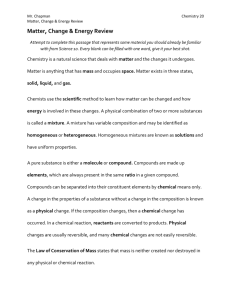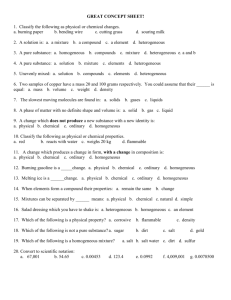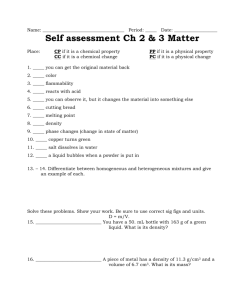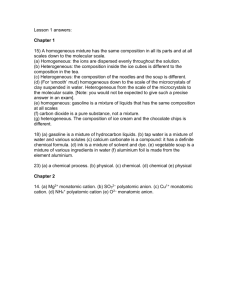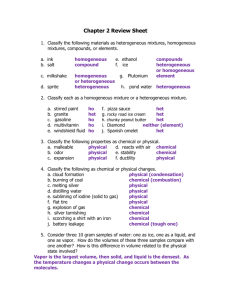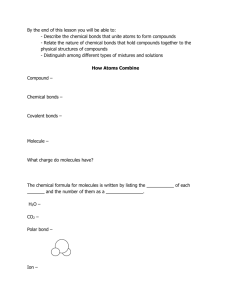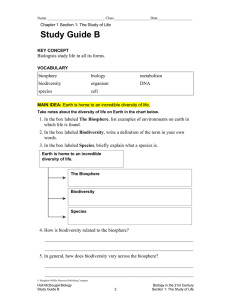1_2 Review
advertisement
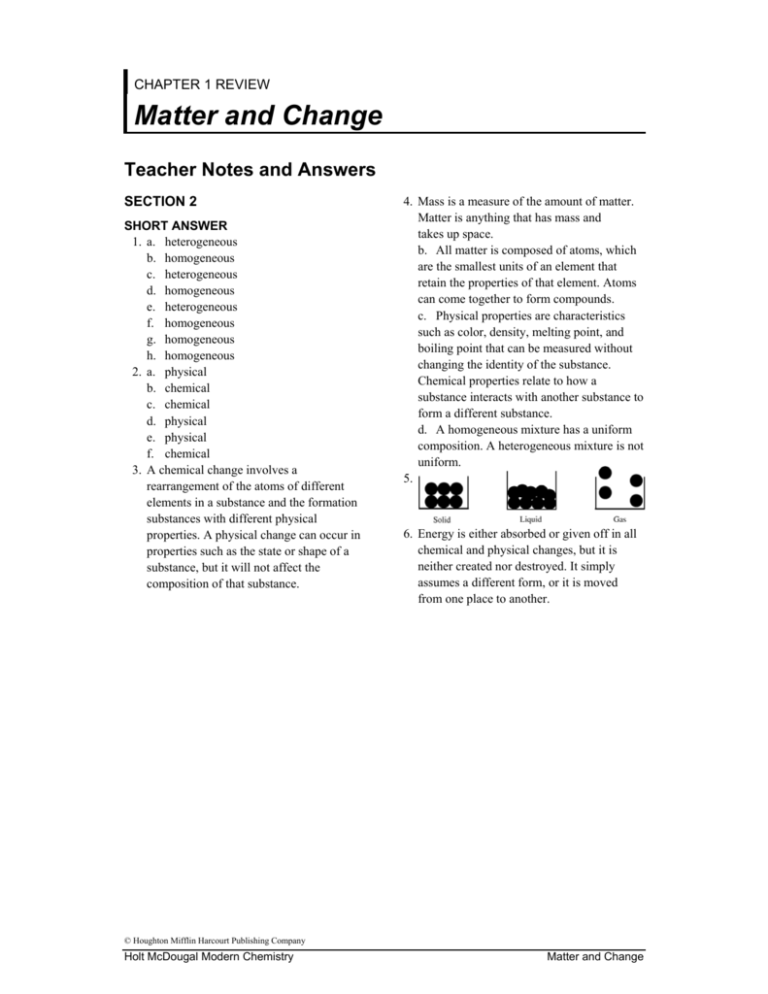
CHAPTER 1 REVIEW Matter and Change Teacher Notes and Answers SECTION 2 SHORT ANSWER 1. a. heterogeneous b. homogeneous c. heterogeneous d. homogeneous e. heterogeneous f. homogeneous g. homogeneous h. homogeneous 2. a. physical b. chemical c. chemical d. physical e. physical f. chemical 3. A chemical change involves a rearrangement of the atoms of different elements in a substance and the formation substances with different physical properties. A physical change can occur in properties such as the state or shape of a substance, but it will not affect the composition of that substance. 4. Mass is a measure of the amount of matter. Matter is anything that has mass and takes up space. b. All matter is composed of atoms, which are the smallest units of an element that retain the properties of that element. Atoms can come together to form compounds. c. Physical properties are characteristics such as color, density, melting point, and boiling point that can be measured without changing the identity of the substance. Chemical properties relate to how a substance interacts with another substance to form a different substance. d. A homogeneous mixture has a uniform composition. A heterogeneous mixture is not uniform. 5. 6. Energy is either absorbed or given off in all chemical and physical changes, but it is neither created nor destroyed. It simply assumes a different form, or it is moved from one place to another. © Houghton Mifflin Harcourt Publishing Company Holt McDougal Modern Chemistry Matter and Change Name:_____________________________ Class: _________________ Date: _________________ CHAPTER 1 REVIEW Matter and Change SECTION 2 SHORT ANSWER Answer the following questions in the space provided. 1. Classify each of the following as a homogeneous or heterogeneous substance. __________________ a. iron ore __________________ b. quartz __________________ c. granite __________________ d. energy drink __________________ e. oil-and-vinegar salad dressing __________________ f. salt __________________ g. rainwater __________________ h. nitrogen 2. Classify each of the following as a physical or chemical change. __________________ a. ice melting __________________ b. paper burning __________________ c. metal rusting __________________ d. gas pressure increasing __________________ e. liquid evaporating __________________ f. food digesting 3. Compare a physical change with a chemical change. _______________________________________________________________ _______________________________________________________________ _______________________________________________________________ _______________________________________________________________ _______________________________________________________________ _______________________________________________________________ © Houghton Mifflin Harcourt Publishing Company Holt McDougal Modern Chemistry 1 Matter and Change Name:_____________________________ Class: _________________ Date: _________________ SECTION 2 continued 4. Compare and contrast each of the following terms: a. mass and matter _______________________________________________________________ _______________________________________________________________ b. atom and compound _______________________________________________________________ _______________________________________________________________ _______________________________________________________________ c. physical property and chemical property _______________________________________________________________ _______________________________________________________________ _______________________________________________________________ _______________________________________________________________ _______________________________________________________________ d. homogeneous mixture and heterogeneous mixture _______________________________________________________________ _______________________________________________________________ _______________________________________________________________ 5. Using circles to represent particles, draw a diagram that compares the arrangement of particles in the solid, liquid, and gas states. 6. How is energy involved in chemical and physical changes? _______________________________________________________________ _______________________________________________________________ _______________________________________________________________ _______________________________________________________________ © Houghton Mifflin Harcourt Publishing Company Holt McDougal Modern Chemistry 2 Matter and Change

